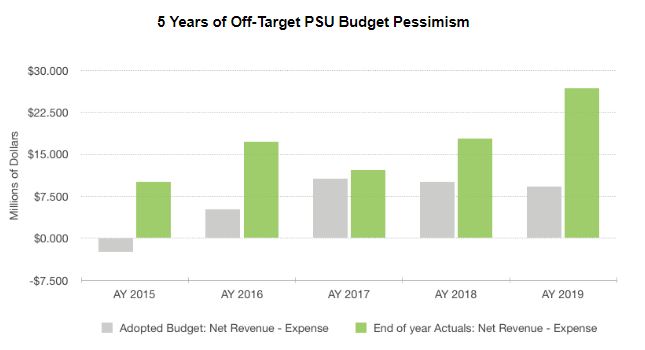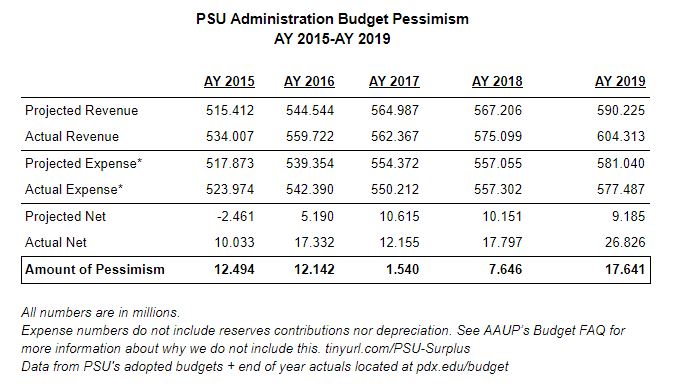On Feb 4, 2020 AAUP and the Faculty Senate held a forum to promote a broader understanding of PSU finances. A large number of colleagues — faculty, staff, graduate employees — attended the forum in Smith 238.
The goal of this AAUP-Faculty Senate forum was to provide information to allow all members of the PSU community to participate fully, and meaningfully, in the conversation around PSU spending and priorities. We presented some data and answered a lot of questions.
In case you did not have an opportunity to attend, and for the benefit of those who did attend, here we share a recap of the forum.
Our Forum Presentation, in a Nutshell
What’s the difference between the 27 million dollar surplus on AAUP posters and the budget shortfall the president and provost are talking about?
Basically, the discrepancy boils down to the following. PSU-AAUP and PSU Administration are talking about two different numbers:
PSU-AAUP has been disseminating information on “actuals” — real data. PSU Administration has been sharing prognostications about the future.
The 27 million dollar surplus PSU-AAUP identified is based on the end-of-year actual numbers from AY 2019 (the year that ended June 30, 2019).
This contrasts with the 8 million dollar shortfall PSU Administration projected for this year, AY 2020, which is a guess about the future.
The 27 million also contrasts with the 9.1 million (“projected net”) surplus PSU Administration predicted for AY 2019 (the last pair of bars in the chart below). That prediction was off by 17 million!
When PSU Administration predicts deficits in its beginning-of-fiscal-year adopted budget, we don’t know until the end of the year if we are really running a deficit.
Based on the last five years, there is good reason to question the accuracy of the projected numbers: they are off, and consistently in one direction. (See graph, Five Years of PSU Off-Target Budget Pessimism).
The difference between PSU Administration’s pessimistic projections, contained in the approved beginning-of-fiscal-year budgets, and what really happens at the end of the year, is what we call the PSU’s Administration’s Budget Pessimism.
Flawed Predictions that are Very Damaging
Projections are always going to be somewhat off target. But consistently wrong projections, of the magnitude we see at PSU, cannot but have a very negative impact on programs, units, and departments. For example, cutbacks are made year in and year out, that are not necessary in light of how finances shake out at the end of the year. This academic year PSU-AAUP has made strong public statements, in letters to Interim President Percy, about cutbacks of great consequence, to Research and Graduate Studies support for researchers, and to the Department of Black Studies. These are but two examples of cutbacks informed by pessimistic and way-off-target budget forecasts. The damage becomes cumulative.
Colleagues in attendance at the session raised many important questions for the PSU administration, which we compiled and we share here.
Years of unwarranted budget pessimism create trends, and we would like to share some indicators suggesting PSU budget and planning has been heading in the wrong direction.
Where is the money going? Administration would like you to believe that staff and faculty salary makes up most of the budget, thus unless we lose people, there is no money to go around. There has been a consistent trend in staffing at PSU. We need to make sure that budget cuts aren’t made at the cost of quality instruction.
Spending on Top Administration vs. Instruction/Research (PSU vs. Peers)
Compared to 44 universities selected as peers by PSU and PSU-AAUP for the purpose of salary comparisons, PSU ranks in the top quarter for spending on administration, where spending on instruction and research, the cornerstones of the mission of the university, PSU is right in the middle. The spending on top administration salaries increased its share of total salaries by 50% between 2008 and 2018, while the share of instructional salaries declined (Data source: IPEDS, https://nces.ed.gov/ipeds/)
What does this say about the priorities at PSU?
Spending on Administration vs. Instruction and Research:
PSU vs. 44 Comparators (2017)
Data Source: IPEDS 2017, https://nces.ed.gov/ipeds/
There is also a discernible trend towards dis-investing in the more stable faculty jobs (tenure-track), and increasingly shifting “the work of the university” to less stable, lower pay, faculty jobs. There is also a notable reduction in graduate employees, with the attendant impact on research, graduate programs, and faculty workloads.
Faculty and Graduate Employees,
Changes 2015 - 2019
Data Source: IPEDS, https://nces.ed.gov/ipeds/
- Note: IPEDS is the “industry-standard” data source. All IPEDS data is based on reporting by universities. It is striking that numbers reported by PSU in the OIRP website do not match IPEDS data.
Percentage changes do not quite capture the full picture: last year there were roughly 1450 part-time faculty (“adjuncts”) employed by PSU. That is twice as many as the sum of our two groups of faculty with access to employment stability: tenure-track faculty (528) and non-tenure track (209). Part-time faculty do not receive health benefits, and a good share of them are staffing, not short-term, but permanent needs.
Basic Take-Aways and Next Steps
Why is there a stark difference between our assessment (and the assessment of credit rating agencies), that PSU finances are healthy, and PSU Administration relentless messaging of crisis?
Because PSU-AAUP is looking at actual data, all of which is publicly available (you can look for yourself and decide how much financial trouble PSU is really in), and PSU Administration’s messaging is based, not on data, but on forecasting, and their forecasting record is very questionable.
It may not be a coincidence that PSU Administration’s current round of “budget pessimism” is occurring while they are at the bargaining with PSU-AAUP, and will shortly be bargaining with the union of part-time faculty, PSUFA.
PSU-AAUP is starting to look into the questions asked by our faculty and friends at the forum and will report back as we get answers.
PSU is hosting two more budget information sessions (Wed Feb 26, 9-11 and Tue March 10, 4-6, 238 SMSU). Come out and ask questions, let administration know that you care about the future of PSU and that cuts to instruction and research hurts PSU.


